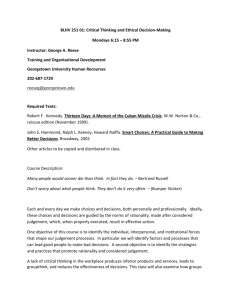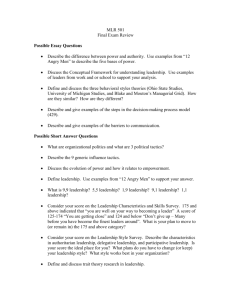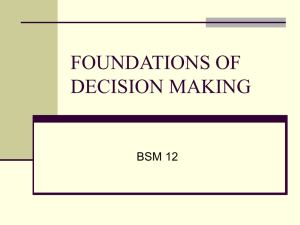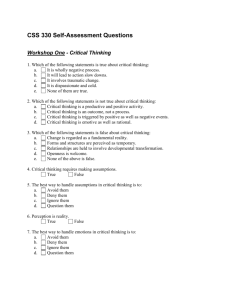Decision-Making Process (cont.)
advertisement
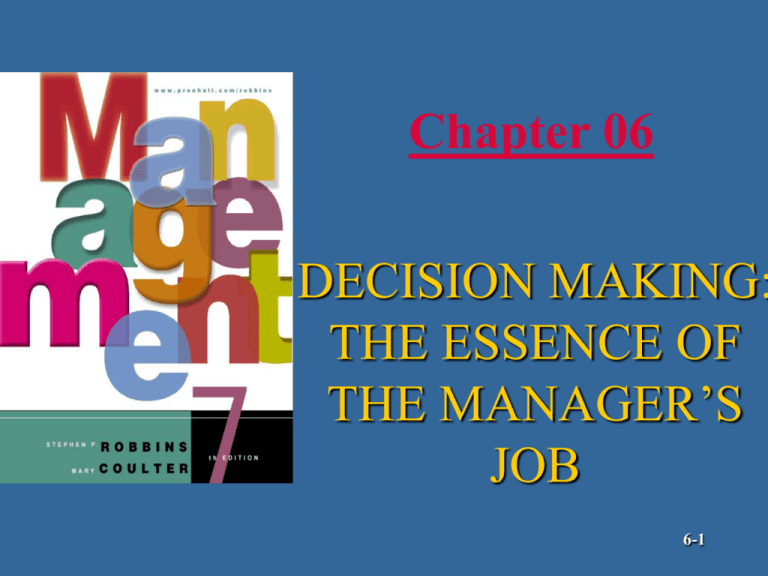
Chapter 06 DECISION MAKING: THE ESSENCE OF THE MANAGER’S JOB 6-1 Learning Objectives You should learn to: 1,Outline the steps in the decision-making process 2,Explain why decision making is so pervasive in organizations 3,Describe the rational decision maker 4,Contrast the perfectly rational and bounded rational approaches to decision making 5,Explain the role that intuition plays in the decision-making process 6-2 Learning Objectives (cont.) You should learn to: 6,Identify the two types of decision problems and the two types of decisions that are used to solve them 7,Differentiate the decision conditions of certainty, risk, and uncertainty 8,Describe the different decision-making styles 6-3 1,Outline the steps in the decision-making process Decisions – choices from two or more alternatives – all organizational members make decisions Decision-Making Process – a comprehensive, 8-step process – Step 1 - Identifying a Problem • problem - discrepancy between an existing and a desired state of affairs – must be such that it exerts pressure to act – manager is unlikely to characterize a situation as a problem unless s/he has necessary resources to act管理者不太可能将某些事情作 为问题,如果他们不具有采取行动的必要资源 6-4 The Decision-Making Process Problem Identification “My salespeople need new computers” Identification of Decision Criteria Price Weight Warranty Screen type Reliability Screen size Allocation of Weights to Criteria Development of Alternatives Reliability 10 Screen size 8 Warranty 5 Weight 5 Price 4 Screen type 3 © Prentice Hall, 2002 Analysis of Alternatives Selection of an Alternative Acer Compaq Gateway HP Micromedia NEC Sony Toshiba Acer Compaq Gateway HP Micromedia NEC Sony Toshiba Acer Compaq Gateway HP Micromedia NEC Sony Toshiba Implementation of an Alternative Gateway Evaluation of Decision Effectiveness 6-5 Decision Making (cont.) Decision-Making Process (cont.) – Step 2 - Identifying Decision Criteria • decision criteria - what’s relevant in making a decision – Step 3 - Allocating Weights to the Criteria • must weight the criteria to give them appropriate priority in the decision – Step 4 - Developing Alternatives • list the viable 可行的alternatives that could resolve the problem without evaluating them – Step 5 - Analyzing Alternatives • each alternative is evaluated against the criteria 6-6 Assessed Values of Notebook Computer Alternatives Against Decision Criteria 6-7 Evaluation of Laptop Computer Alternatives Against Criteria and Weights 6-8 Decision Making (cont.) Decision-Making Process (cont.) – Step 6 - Selecting an Alternative • choosing the best alternative from among those considered – Step 7 - Implementing the Alternative • implementation - conveying the decision to those affected by it and getting their commitment to it – participation in decision-making process inclines people to support the decision – decision may fail if it is not implemented properly – Step 8 - Evaluating Decision Effectiveness • determine whether the problem is resolved 6-9 2,Explain why decision making is so pervasive in organizations 6-10 3,Describe the rational decision making l Rational Decision Making – decisions are consistent前后一致的, value-maximizing choices within specified constraints – managers assumed to make rational decisions – Assumptions of Rationality - decision maker would: – be objective and logical – carefully define a problem – have a clear and specific goal – select the alternative that maximizes the likelihood of achieving the goal – make decision in the firm’s best economic interests • managerial decision making seldom meets all the tests 6-11 Assumptions Of Rationality Single, welldefined goal is to be achieved All alternatives and consequences are known Preferences are clear Preferences偏好 are constant and stable Problem is clear and unambiguous Rational Decision Making Final choice will maximize payoff No time or cost constraints exist 6-12 4,Contrast the perfectly rational and boundedly rational approaches to decision making Bounded Rationality – behave rationally within the parameters参数 of a simplified decision-making process that is limited by an individual’s ability to process information – satisfice满意 - accept solutions that are “good enough” Is a common error committed in the DM process? escalation of commitment - increased commitment to a previous decision despite evidence that it may have been wrong • refusal to admit that the initial decision may have been flawed 6-13 5,Explain the role that intuition plays in the decision-making process Role of Intuition – intuitive decision making - subconscious process of making decisions on the basis of experience and accumulated judgment • does not rely on a systematic or thorough analysis of the problem • generally complements a rational analysis 6-14 What Is Intuition? Decisions based on ethical values or culture Values or ethics-based decisions Subconscious mental processing Decisions based on subconscious data Decisions based on experience Experiencedbased decisions Intuition Decisions based on feelings and emotions Affectinitiated decisions Cognitive认知的based decisions Decisions based on skills, knowledge, or training 6-15 6,Identify the two types of decision problems and the two types of decisions that are used to solve them Types of Problems and Decisions – Well-Structured Problems - straightforward, familiar, and easily defined – Programmed Decisions - used to address structured problems – minimize the need for managers to use discretion – facilitate organizational efficiency • procedure - series of interrelated sequential steps顺 序的步骤used to respond to a structured problem • rule - explicit 清楚的 statement of what to do or not to do • policy - guidelines or parameters for decision 6-16 making 6,Identify the two types of decision problems and the two types of decisions that are used to solve them Types of Problems and Decisions (cont.) – Poorly-Structured Problems - new, unusual problems for which information is ambiguous or incomplete – Nonprogrammed Decisions - used to address poorly- structured problems • produce a custom-made response • more frequent among higher-level managers – few decisions in the real world are either fully programmed or nonprogrammed 6-17 Types Of Problems, Types Of Decisions, And Level In The Organization Ill-structured Type of Problem Top Nonprogrammed Decisions Level in Organization Programmed Decisions Well-structured Lower 6-18 7,Differentiate the decision conditions of certainty, risk, and uncertainty Decision-Making Conditions – Certainty - outcome of every alternative is known • idealistic rather than realistic – Risk - able to estimate the probability of outcomes stemming from each alternative • expected value - the conditional return from each possible outcome – multiply expected revenue from each outcome by the probability of each outcome 6-19 Expected Value for Revenues from the Addition of One Ski Lift 6-20 Decision Trees Value of loss and profit probability Outcome Branch of point solution Decision point Expected Value= Value of loss and profit* probability © Prentice Hall, 2002 6 2 example strong0·70 Rent 20,000sq.ft weak0·30 $320,000 Expected value 320*0·70+50*0·3 $50,000 0=239 P125 Rent 12,000sq.ft strong0·70 weak0·30 © Prentice Hall, 2002 $240,000 $130,000 Expected value 240*0·70+130 *0·30=207 6 2 例:某公司计划开发一种新产品,设计了豪华型和 普及型两个型号:个型号: 豪华型: 成功盈利800万元,成功的概率为60%, 失败亏损300万元. 失败的概率为40%; 普及型: 成功盈利600万元. 成功的概率为70%. 失败亏损 30万元. 失败的概率为30%。 © Prentice Hall, 2002 6 2 决策方案 自然状态及概率 支付值 成功0·60 豪华型 普及型 失败 0·40 成功 0·70 失败 0·30 © Prentice Hall, 2002 期望值 800 800*0·60+(-300) *0·40=360 -300 600 600*0·70+(-30) *0·30=411 -30 6 2 Decision-Making Conditions (cont.) – Uncertainty - not certain about outcomes and unable to estimate probabilities • psychological orientation of decision maker – maximax choice - optimistic » maximizing the maximum possible payoff 最大最大选择 – maximin choice - pessimistic » maximizing the minimum possible payoff 最大最小选择 – minimax - minimize the maximum “regret” – 最小化其最大遗憾 6-25 Payoff Matrix收益矩阵 6-26 Regret Matrix(遗憾矩阵) 6-27 8,Describe the different decision-making styles Decision-Making Styles决策风格 – two dimensions define the approach to decision making • way of thinking - differs from rational to intuitive • tolerance for ambiguity模糊承受力 - a high need for consistency and order in making decision so that ambiguity is minimized. • define four decision-making styles • Directive - fast, efficient, and logical • Analytic - careful and able to adapt or cope with new situations • Conceptual - able to find creative solutions 6-28 • Behavioral - seek acceptance of decisions Decision-Making Styles Tolerance for Ambiguity High Analytic Conceptual Directive Behavioral Low Rational Way of Thinking Intuitive 6-29 What are Advantages &Disadvantages in Group Decision Making? – Advantages - diverse employees: • provide fresh perspectives • offer differing interpretations of problem definition • increase the likelihood of creative and unique solutions – Disadvantages - diverse employees: • require more time to reach a decision • may have problems of communication • may create a more complex, confusing, and ambiguous decision-making process • may have difficulty in reaching agreement 6-30 Overview Of Managerial Decision Making Decision-Making Approach • Rationality • Bounded Rationality • Intuition Types of Problems and Decisions • Well-structured - programmed • Poorly structured - nonprogrammed Decision-Making Conditions • Certainty • Risk • Uncertainty Decision-Making Process Decision Maker Style • Directive • Analytic • Conceptual • Behavioral Decision • Choose best alternative - maximizing - satisficing • Implementing • Evaluating 6-31

